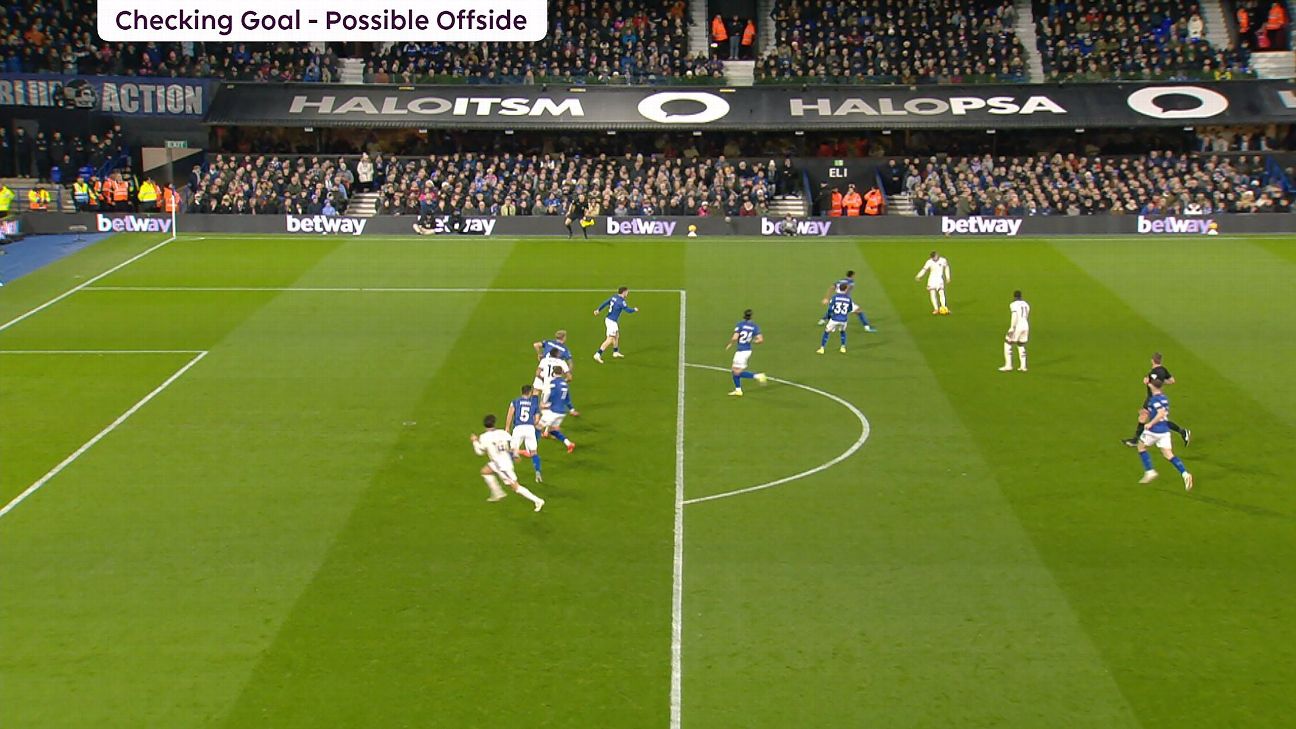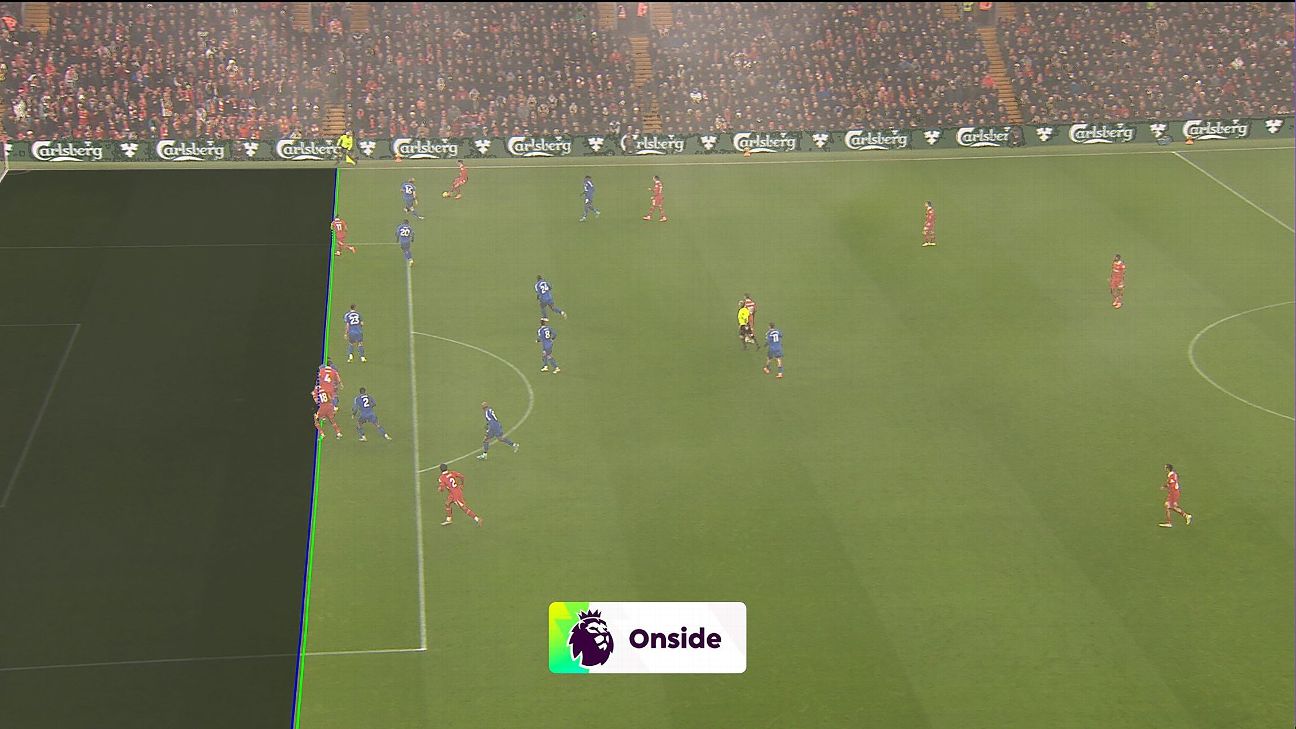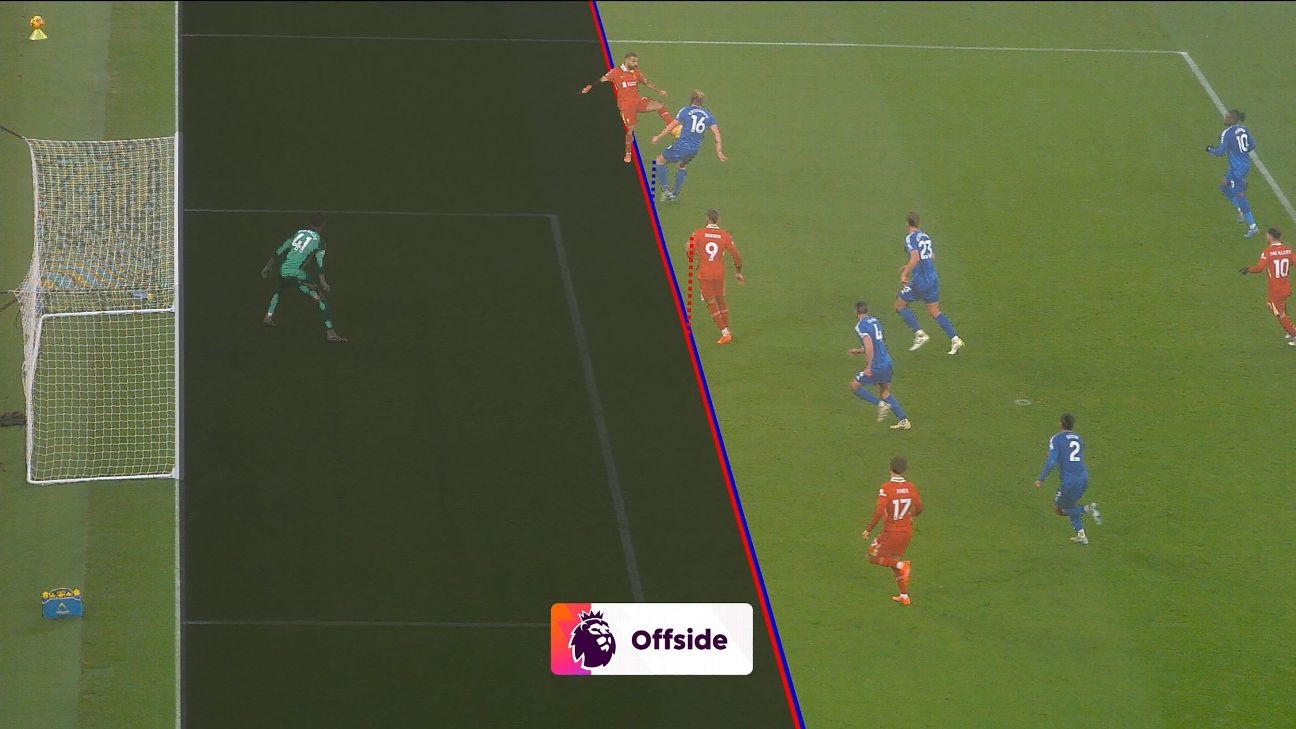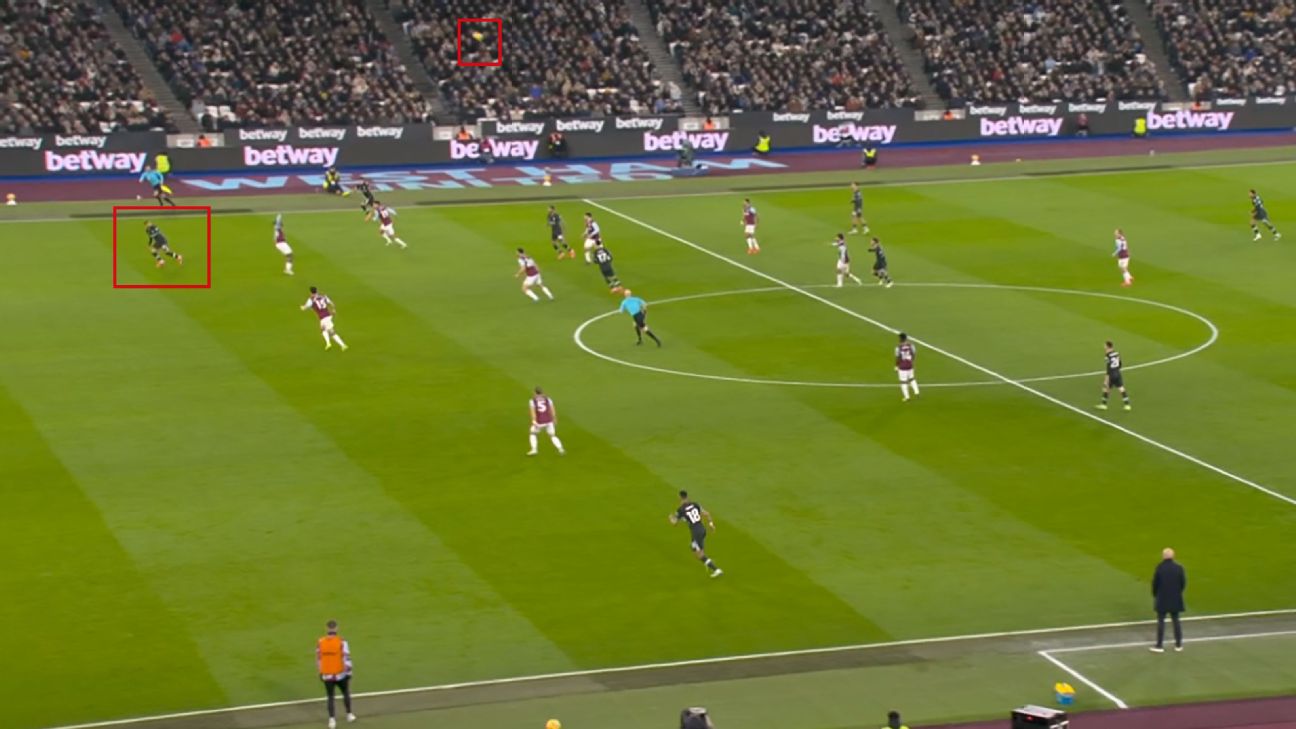Video Assistant Referee causes controversy every week in the Premier League, but how are decisions made, and are they correct?
We take a look at the major incidents, to examine and explain the process both in terms of VAR protocol and the Laws of the Game.
In this week’s VAR Review: Were Ipswich Town fortunate to get a penalty against Chelsea? Should João Pedro have been sent off against Brentford? Was the VAR right to give Aston Villa a spot kick against Brighton? Plus, all the other high-profile incidents from across the festive programme of fixtures.
Possible penalty overturn: Jørgensen foul on Delap
What happened: Ipswich Town were awarded a penalty in the 10th minute when Liam Delap went to ground under a challenge from Chelsea goalkeeper Filip Jørgensen. Did the striker dive? It was reviewed by the VAR, Michael Oliver.
VAR decision: Penalty stands, scored by Delap.
VAR review: Delap got to the ball first but, just after he got back up to continue, the Ipswich striker went down and appealed for the penalty. Jørgensen had given the referee a decision to make by rushing out and not winning the ball.
We’ve seen this kind of situation pretty regularly, and protocol says that if lower-body contact can be confirmed, then the decision should stand — unless it has been initiated by the attacker. See Newcastle United’s Anthony Gordon being brought down by minimal contact from Manchester City goalkeeper Ederson, or Liverpool’s Diogo Jota winning a spot kick off Newcastle’s Martin Dúbravka.
As referee John Brooks gave the penalty on the field, the VAR attempted to prove he’s definitely got it wrong. Is there really evidence of contact? Or is it just that the VAR cannot be certain there wasn’t any? The VAR deemed it sufficient, though it was incredibly difficult to determine.
Verdict: This wouldn’t have been a penalty through VAR. You couldn’t say with confidence that the goalkeeper caught the attacker. Yet, it was also hard to say without any doubt that Delap wasn’t clipped as the goalkeeper slid in to challenge.
Most fans probably felt this shouldn’t be a penalty, that Delap went down too easily. With Gordon and Jota, there was proof of a small clip, but it was not so clear with Delap.
Was it a penalty? Probably not. But with the way VAR works, it was unlikely to get overturned.
BONUS BIT: The VAR intervention to disallow João Félix’s goal for offside was yet another lengthy review (more on this later), taking two minutes and 41 seconds from the goal to referee Brooks ruling it out.
The VAR was having trouble finding an angle to place the offside lines, as Felix was obscuring the feet of the defenders on the main camera. After checking a number of angles, the VAR decided that while the lines couldn’t be displayed there was clear evidence that the Chelsea attacker was ahead of the defence when the pass was played by Cole Palmer.

Possible red card: Violent conduct by Pedro on Yarmoliuk
What happened: João Pedro was pulled back by Yehor Yarmoliuk on the halfway line in the 75th minute. However, after he had broken free, Pedro swung an elbow in the direction of Yarmoliuk. Referee Andy Madley produced a yellow card for the Brentford player for stopping a promising attack and took no action against Pedro. The VAR, Chris Kavanagh, checked for possible violent conduct by Brighton & Hove Albion forward Pedro.
VAR decision: No red card.
VAR review: “As I understand the rules, you can’t swing an arm to hit someone, whether you hit them or not,” Brentford boss Thomas Frank said.
Brighton manager Fabian Hürzeler had a different view: “For me it’s not a red card. Why would it be a red card? You just try to get free from someone.”
Hürzeler’s comment was perhaps a more loose interpretation, but it’s clear the VAR believed this fell somewhere between the two. Whatever Pedro’s true intentions, it was clear this was a dangerous and violent action and football would expect a red card.
So, how did the Brighton player escape a VAR review?
Contact isn’t necessary for violent conduct. Indeed, the law defines it as when “a player uses or attempts to use excessive force … regardless of whether contact is made.”
Pedro checked over his shoulder, and then threw his elbow back. Was this intimidation, or was it violent? If a player gestures a headbutt but does not intend to make any contact, would we expect a red card there, too? If there was no likelihood of ever hitting the opponent, could it really be violent conduct?
Earlier this month, Tottenham Hotspur’s Dejan Kulusevski escaped a red card when his elbow connected with the head of Chelsea’s Romeo Lavia. There was no throwing action from Kulusevski, but there was a strong case that he knew exactly what he was doing. The Premier League’s Key Match Incidents (KMI) Panel voted on a split 3-2 decision that no red card was correct on field, and 4-1 for no VAR intervention.
Pedro had a more obvious striking motion, and would have caused far more damage to Yarmoliuk had he connected.
Verdict: Did Pedro know exactly where Yarmoliuk was, or did he simply miss? We shouldn’t try to guess judgment over luck with this kind of action, allowing players to throw an elbow just because they feel aggrieved.
It was a bizarre situation, and one that would have yielded few complaints had it led to a VAR red card. Indeed, when it’s more difficult to explain why a decision hasn’t been given, that’s probably because it was the optimal one.
Last season, two players should have been sent off for an elbow but their challenges were cleared by the VAR: Newcastle’s Bruno Guimarães vs. Arsenal, and Brighton’s Pascal Groß vs. Fulham.
Kulusevski and Pedro both escaped without any disciplinary sanction when they should at the very least have received a yellow card — but the VAR cannot advise this.
Possible penalty: Challenge by Pedro on Rogers
What happened: Aston Villa won a corner in the 32nd minute. Brighton goalkeeper Bart Verbruggen palmed the ball inside the six-yard box, with João Pedro challenging Morgan Rogers for the loose ball. Play continued with Lucas Digne seeing a shot saved before it went behind for a corner. However, the VAR, Stuart Attwell, checked for a penalty and sent referee Craig Pawson to the monitor.
VAR decision: Penalty, scored by Ollie Watkins.
VAR review: Rogers got to the ball ahead of Pedro, who kicked the Aston Villa midfielder after getting there marginally later.
We’ve seen many similar situations that haven’t resulted in a penalty, including when Douglas Luiz kicked the foot of Arsenal’s Gabriel Jesus last season.
Verdict: When both players go into a challenge at a similar time, and have a realistic prospect of winning the ball, the VAR has very rarely got involved to give a penalty. This was the case here, too, and how VAR operates in the Premier League means we shouldn’t be seeing an intervention for a spot kick.
Possible red card: Christie foul on Robinson
What happened: Ryan Christie strongly challenged Antonee Robinson in the 42nd minute and was shown a yellow card by referee Rob Jones. Was there a case for a red card through the VAR, Peter Bankes? (watch here)
VAR decision: No red card.
VAR review: While Christie was off the ground, he led with one foot and made only small contact with Robinson’s shin.
The fact that Christie’s foot came off the ball first is irrelevant; it’s how he connects with the opponent (as usual, see Liverpool’s Curtis Jones at Tottenham Hotspur last season.)
If there had been any more contact, then it would have been a VAR intervention.
There are similarities to Moisés Caicedo’s challenge on Pape Matar Sarr in Chelsea vs. Tottenham, which also didn’t lead to a VAR review at the pitchside monitor — an outcome supported by Howard Webb and the KMI Panel.
Verdict: This is right on the borderline between yellow and red, unlike the challenge by Brighton’s Pervis Estupiñán on Max Kilman before Christmas which should have resulted in a VAR intervention.
The KMI Panel may log this as a red card on the field, but it’s not at the threshold for VAR.
Possible foul: Mateta on Ramsdale for Chalobah goal
What happened: Crystal Palace equalised from a corner in the 31st minute when Trevoh Chalobah helped the ball home at the near post, but was there a foul on goalkeeper Aaron Ramsdale by Jean-Philippe Mateta? Referee Michael Salisbury gave the goal, and the decision was checked by the VAR, Graham Scott.
VAR decision: Goal stands.
VAR review: We’ve seen this regularly in recent seasons, and the goal would almost certainly be disallowed on the continent. But as Palace boss Oliver Glasner said after the game: “It’s a foul all over Europe but not in England and not in the Premier League. It’s world-famous and No. 1 with this way of playing. Not every contact is a foul. It’s a regular goal for Premier League football.”
We’ll see goals ruled out by the referee for similar levels of contact, but it’s highly unlikely to happen through VAR.
It’s a borderline call, however, as Mateta does extend an arm to the goalkeeper. At the same time, they appear to be engaged with each other, so the on-field decision stood.
It wasn’t the only such goal over Christmas. Matheus Cunha scored for Wolverhampton Wanderers direct from a corner against Manchester United, but goalkeeper André Onana may have been fouled as the ball came over. (watch here)
Matt Doherty and Santiago Bueno were on either side of Onana. However, Bueno was actually being challenged by Manuel Ugarte and ended up close to the goalkeeper.
So, did Doherty commit any offence? An attacking player is able to stand his ground; he cannot move into the way of a goalkeeper or hold them. It’s Onana who appeared to engage Doherty, rather than the attacker causing a foul.
It’s similar to a goal scored direct from a corner by Aston Villa’s Douglas Luiz at Arsenal in August 2022, when Boubacar Kamara stood in front of Aaron Ramsdale. That goal was upheld following a VAR review.
Verdict: The VAR isn’t going to intervene unless the goalkeeper’s ability to play the ball has clearly been impacted, or if an attacker has moved to stop him getting to it. An attacker standing their ground won’t lead to a goal being disallowed.
The last time such a goal was ruled out through VAR was just over a year ago, when Sheffield United goalkeeper Wes Foderingham was impeded by Aston Villa’s Jacob Ramsey.
Possible handball: Joelinton when scoring
What happened: Joelinton doubled Newcastle’s lead in the 19th minute when he helped home a cross by Anthony Gordon. But was there a handball by the goal scorer? (watch here)
VAR decision: Goal stands.
VAR review: At the start of the season, AFC Bournemouth had a late winning goal disallowed, coincidentally against Newcastle, for handball against Dango Ouattara.
The situations are very similar, with both players jumping to win a header and the ball going in off the upper arm.
Verdict: Ouattara’s goal shouldn’t have been disallowed and was confirmed as an error by referees’ chief Howard Webb. There wasn’t conclusive evidence to say the ball hit him low enough on the arm for it to be a handball offense, and the same applies to Joelinton.
The VAR, Paul Tierney, was correct to allow this goal to stand.
Possible offside: Salah in buildup to Jones goal
What happened: Liverpool took the lead in the 49th minute when Curtis Jones scored from close range. However, there was a lengthy check for offside against Mohamed Salah.
VAR decision: Goal stands.
VAR review: This was one of two VAR offside checks on Liverpool goals that seemed to take an age — a total of three minutes from the goal being scored to the referee signalling it would stand.
The second took even longer, three minutes and 42 seconds to look at two situations and confirm Darwin Núñez committed an offside offence before Cody Gakpo put the ball in the net.
Both were correct on-field, and while subjective checks have become quicker, offside decisions regularly sap the life out of games. And with semi-automated offside technology now highly unlikely to arrive this season, it’s not going to change anytime soon.

The Salah check was worse because it was so unnecessary, going back some 18 seconds before the goal was scored.
Time doesn’t define an attacking phase; it’s about the general direction of play and if a defending team is set. Even though a Leicester player may have got a touch in attempting an interception, the phase wouldn’t be reset. It has to be controlled possession.
You could argue that the very first pass by Salah, played back down the touchline to Jones (who shortly afterward made a run into the box) should reset the phase as the forward momentum had ended. And when scoring, Jones made the eighth touch by a Liverpool player after Salah received the ball. In the Premier League, it’s exceptionally rare for the VAR to go so far back.
The second check, which supported Núñez being offside, caused confusion due to the image displayed. The ball was played by Salah, but because the Egyptian was ahead of the line drawn to Núñez, many thought it couldn’t be offside.
The position of the player making the pass doesn’t matter. The only relevant factors are the attacking player who receives the ball, and then either the ball or the second-last opposition player.
Salah was reaching behind himself to play the pass, which meant he was stood over the line drawn to Núñez. But as Núñez was ahead of the ball, he had to be behind the second-last opponent — but he was marginally in front. Núñez then made an attempt to play the ball before it ran to Gakpo.

Verdict: While arguably a valid offside check by the VAR, Chris Kavanagh, it was stretching the protocol applied in the Premier League. The goal should have been allowed to stand without looking at Salah’s offside position.
BONUS BIT: There was a claim for offside against Salah in the victory over West Ham United on Sunday, when he moved toward a long ball over the top but left it for Luis Díaz before then receiving a pass to set up Gakpo to score.
A player cannot be offside simply by running; if they don’t touch the ball, the judgment is always about impact on an opponent. Salah quickly changed his run, didn’t look to engage with the ball and didn’t have an opponent close, so there was no offside offence.

Possible red card overturn: Durán violent conduct on Schär
What happened: Fabian Schär and Jhon Durán chased a long ball in the 31st minute. Schär got there first and played it out for a throw-in. As the two players landed on the ground, Durán caught the Newcastle United defender on the back with his foot. Referee Anthony Taylor took his time to make a decision before brandishing a red card for violent conduct. It was checked by the VAR, Graham Scott.
VAR decision: Red card stands.
VAR review: Quite often we’ll see situations like this, and usually a referee decides to issue a yellow card. When the decision goes to VAR, it’s about determining the offending player’s intentions: Was it a natural collision or a coming together, or did they know exactly what they were doing?
Did Durán mean the kick at Schär, or was it a consequence of losing his balance? The VAR couldn’t be certain, so there was no intervention on the on-field judgment.
Aston Villa lost their appeal against Durán’s three-match ban, which shows the vagaries of the laws and the process. Christian Nørgaard’s red card for Brentford at Everton for a serious foul play tackle on Jordan Pickford was rescinded, yet Durán’s violent conduct appeal was unsuccessful. Maybe Durán had a stronger case than Nørgaard, but you can’t predict how the panel of three former players on the Football Association disciplinary commission will vote.
Verdict: There’s enough doubt about Durán’s intentions to think that if referee Taylor had booked Durán, then he wouldn’t have been sent to the monitor. It could be seen as petulant, and a yellow card wouldn’t be changed.
And that’s where the contradiction of this system of VAR comes in. Taylor did show the red card, and that also wouldn’t be seen as wrong.
Possible red card overturn: Rodríguez challenge on Walker-Peters
What happened: Guido Rodríguez was shown a red card by referee Lewis Smith in the 51st minute for a strong tackle on Southampton’s Kyle Walker-Peters. The VAR, Stuart Attwell, checked the decision.
VAR decision: Red card downgraded to yellow.
VAR review: It’s the first time the VAR has stepped in to cancel a red card this season, though an intervention was missed for Manchester United captain Bruno Fernandes’ dismissal vs. Tottenham Hotspur.
Referee Smith felt there had been strong contact by Rodríguez on Walker-Peters’ shin, yet the replays showed that the tackle stopped short and there was minimal connection on the boot — it certainly didn’t endanger the safety of an opponent or have excessive force for serious foul play.
Verdict: Correct VAR intervention and the kind of clear error people expected VAR to concentrate on when it came into the game seven years ago.
Some factual parts of this article include information provided by the Premier League and PGMOL.



